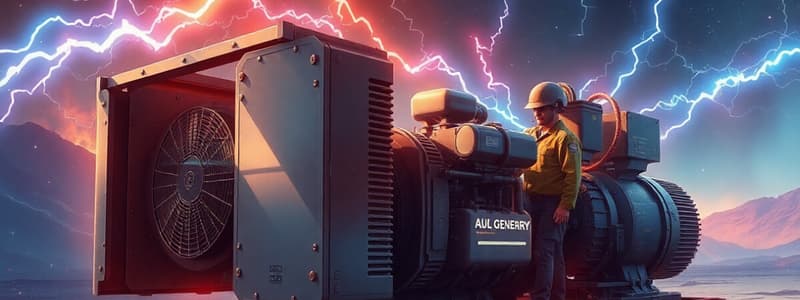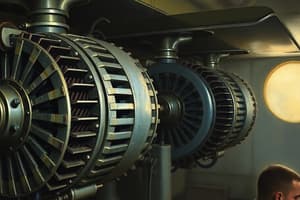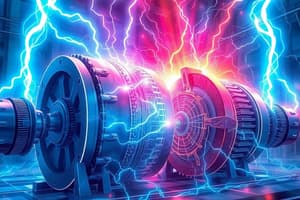Podcast
Questions and Answers
What is one of the main advantages of a permanent magnet generator (PMG)?
What is one of the main advantages of a permanent magnet generator (PMG)?
- Needs brushes for operation
- Low maintenance requirements (correct)
- Operates only in voltage mode
- Requires constant power supply to the field
Which aircraft components typically receive power from a permanent magnet alternator (PMA)?
Which aircraft components typically receive power from a permanent magnet alternator (PMA)?
- Battery charging system
- Landing gear system
- Flight control surfaces
- Ignition exciter and FADEC (correct)
In context of brushless alternators, what does the exciter field do?
In context of brushless alternators, what does the exciter field do?
- Induces voltage into the armature (correct)
- Induces voltage into the output field winding
- Generates power for the load directly
- Creates electrical current for auxiliary systems
What type of magnetic field do brushless alternators primarily utilize?
What type of magnetic field do brushless alternators primarily utilize?
How is the output from the exciter rectified in a brushless alternator?
How is the output from the exciter rectified in a brushless alternator?
What determines the AC output power of a permanent magnet generator?
What determines the AC output power of a permanent magnet generator?
What feature do brushless alternators eliminate that is often problematic at high altitudes?
What feature do brushless alternators eliminate that is often problematic at high altitudes?
In which operation mode can permanent magnet alternators (PMAs) function?
In which operation mode can permanent magnet alternators (PMAs) function?
What is the significance of phase sequence in three-phase connections?
What is the significance of phase sequence in three-phase connections?
How is the output frequency of an alternator calculated?
How is the output frequency of an alternator calculated?
What output frequency can be expected from an alternator with 8 poles driven at 6000 rpm?
What output frequency can be expected from an alternator with 8 poles driven at 6000 rpm?
What adjustment is made to the hydraulic pump in a Constant Speed Drive (CSD)?
What adjustment is made to the hydraulic pump in a Constant Speed Drive (CSD)?
At what speed must a 6 pole alternator be driven to achieve a 400 Hz output frequency?
At what speed must a 6 pole alternator be driven to achieve a 400 Hz output frequency?
What is the primary advantage of using a three-phase connection?
What is the primary advantage of using a three-phase connection?
What does the Integrated Drive Generator (IDG) combine?
What does the Integrated Drive Generator (IDG) combine?
In a three-phase system, what is the effect if the phase sequence is changed to A, C, B?
In a three-phase system, what is the effect if the phase sequence is changed to A, C, B?
What does the vertical axis of a sine wave represent?
What does the vertical axis of a sine wave represent?
When does the induced voltage of a simple AC generator reach its maximum positive value?
When does the induced voltage of a simple AC generator reach its maximum positive value?
What happens to the induced voltage as the armature rotates from 180º to 270º?
What happens to the induced voltage as the armature rotates from 180º to 270º?
What characterizes the waveform of a single-phase alternator?
What characterizes the waveform of a single-phase alternator?
What is true regarding the full cycle of a sine wave representing AC?
What is true regarding the full cycle of a sine wave representing AC?
What occurs at the initial position (0º) of the armature in a simple AC generator?
What occurs at the initial position (0º) of the armature in a simple AC generator?
How are the stator windings connected in a single-phase alternator?
How are the stator windings connected in a single-phase alternator?
What is the primary characteristic of two-phase alternators?
What is the primary characteristic of two-phase alternators?
During which segment does the induced voltage in the simple AC generator begin to decrease?
During which segment does the induced voltage in the simple AC generator begin to decrease?
In a two-phase, three-wire alternator, what is the relationship between the voltages at points A, B, and C?
In a two-phase, three-wire alternator, what is the relationship between the voltages at points A, B, and C?
Which statement about a two-phase alternator's windings is accurate?
Which statement about a two-phase alternator's windings is accurate?
What does the generator control unit (GCU) primarily monitor and regulate?
What does the generator control unit (GCU) primarily monitor and regulate?
What is the output voltage phase relationship in a two-phase alternator?
What is the output voltage phase relationship in a two-phase alternator?
Why are two-phase alternators seldom seen in actual use?
Why are two-phase alternators seldom seen in actual use?
What happens in the GCU if additional output is required from the generator?
What happens in the GCU if additional output is required from the generator?
What is the purpose of the dotted wire in a two-phase, three-wire alternator?
What is the purpose of the dotted wire in a two-phase, three-wire alternator?
Which component is NOT part of the brushless alternator assembly?
Which component is NOT part of the brushless alternator assembly?
What characteristic describes a sinusoidal (sine) wave?
What characteristic describes a sinusoidal (sine) wave?
What output configuration provides additional advantages in a two-phase alternator?
What output configuration provides additional advantages in a two-phase alternator?
What type of alternators are typically used in aircraft AC generators?
What type of alternators are typically used in aircraft AC generators?
How does the induced electromotive force (EMF) relate to the magnetic field?
How does the induced electromotive force (EMF) relate to the magnetic field?
What effect does a higher exciter output have on the alternator's performance?
What effect does a higher exciter output have on the alternator's performance?
What defines the flow of electrons in alternating current (AC)?
What defines the flow of electrons in alternating current (AC)?
What is the primary winding configuration used in the three-phase output stator of the brushless alternator?
What is the primary winding configuration used in the three-phase output stator of the brushless alternator?
In a star-connected system, how does the line current compare to the phase current?
In a star-connected system, how does the line current compare to the phase current?
What is the relationship between line voltage and phase voltage in a delta-connected system?
What is the relationship between line voltage and phase voltage in a delta-connected system?
What is the correct formula to calculate power consumed in a three-phase circuit?
What is the correct formula to calculate power consumed in a three-phase circuit?
How do you calculate power in kilowatts (kW) from line values in a three-phase system?
How do you calculate power in kilowatts (kW) from line values in a three-phase system?
In a star connection, how is line voltage defined in terms of phase voltage?
In a star connection, how is line voltage defined in terms of phase voltage?
What does the power factor Cosθ represent in the power calculation formula for a three-phase circuit?
What does the power factor Cosθ represent in the power calculation formula for a three-phase circuit?
In a three-phase system, how is the line current defined in a delta connection?
In a three-phase system, how is the line current defined in a delta connection?
What is the significance of the factor 1.732 in the power calculation formulas pertaining to three-phase systems?
What is the significance of the factor 1.732 in the power calculation formulas pertaining to three-phase systems?
Flashcards
Rotating Field Alternator
Rotating Field Alternator
A type of alternator commonly used in aircraft where the magnetic field rotates, while the armature remains stationary. This design eliminates the need for sliding contacts, improving reliability.
Permanent Magnet Generator (PMG)
Permanent Magnet Generator (PMG)
A generator that uses permanent magnets to create the magnetic field instead of electromagnets. PMGs are typically compact and require no external power to operate.
PMG Advantages
PMG Advantages
PMGs offer several advantages, including high efficiency, low maintenance, and the ability to operate in harsh environments. They're often used in gas turbine engines to power essential systems.
PMG Applications
PMG Applications
Signup and view all the flashcards
Brushless Alternator
Brushless Alternator
Signup and view all the flashcards
Brushless Alternator Excitation
Brushless Alternator Excitation
Signup and view all the flashcards
Brushless Alternator Features
Brushless Alternator Features
Signup and view all the flashcards
Brushless Alternator Operation
Brushless Alternator Operation
Signup and view all the flashcards
GCU (Generator Control Unit)
GCU (Generator Control Unit)
Signup and view all the flashcards
Exciter
Exciter
Signup and view all the flashcards
Sinusoidal Wave
Sinusoidal Wave
Signup and view all the flashcards
Induced EMF
Induced EMF
Signup and view all the flashcards
Alternating Current (AC)
Alternating Current (AC)
Signup and view all the flashcards
Wye Wound (Y)
Wye Wound (Y)
Signup and view all the flashcards
Laminated Frame
Laminated Frame
Signup and view all the flashcards
What does the vertical axis of an AC sine wave represent?
What does the vertical axis of an AC sine wave represent?
Signup and view all the flashcards
What does the horizontal axis of an AC sine wave represent?
What does the horizontal axis of an AC sine wave represent?
Signup and view all the flashcards
What is the significance of a sine wave crossing the time axis?
What is the significance of a sine wave crossing the time axis?
Signup and view all the flashcards
What is the value of voltage induced at 0 degrees in an AC generator?
What is the value of voltage induced at 0 degrees in an AC generator?
Signup and view all the flashcards
What happens to the induced voltage as the armature rotates from 0 to 90 degrees?
What happens to the induced voltage as the armature rotates from 0 to 90 degrees?
Signup and view all the flashcards
What happens to the induced voltage as the armature rotates from 90 to 180 degrees?
What happens to the induced voltage as the armature rotates from 90 to 180 degrees?
Signup and view all the flashcards
What happens to the induced voltage as the armature rotates from 180 to 270 degrees?
What happens to the induced voltage as the armature rotates from 180 to 270 degrees?
Signup and view all the flashcards
What is a single-phase alternator?
What is a single-phase alternator?
Signup and view all the flashcards
Single-Phase Alternator
Single-Phase Alternator
Signup and view all the flashcards
Two-Phase Alternator
Two-Phase Alternator
Signup and view all the flashcards
Two-Phase Three-Wire Alternator
Two-Phase Three-Wire Alternator
Signup and view all the flashcards
Output Voltage (C)
Output Voltage (C)
Signup and view all the flashcards
Advantages of Two-Phase Alternator
Advantages of Two-Phase Alternator
Signup and view all the flashcards
Three-Phase Alternator
Three-Phase Alternator
Signup and view all the flashcards
Polyphase
Polyphase
Signup and view all the flashcards
Aircraft AC Generators
Aircraft AC Generators
Signup and view all the flashcards
Three-Phase Winding
Three-Phase Winding
Signup and view all the flashcards
Star Connection (Y)
Star Connection (Y)
Signup and view all the flashcards
Delta Connection
Delta Connection
Signup and view all the flashcards
Line Current (Delta)
Line Current (Delta)
Signup and view all the flashcards
Power in 3-Phase Systems
Power in 3-Phase Systems
Signup and view all the flashcards
kVA Rating
kVA Rating
Signup and view all the flashcards
kW Rating
kW Rating
Signup and view all the flashcards
Phase Sequence
Phase Sequence
Signup and view all the flashcards
Three-Phase Connection Advantages
Three-Phase Connection Advantages
Signup and view all the flashcards
Alternator Output Frequency
Alternator Output Frequency
Signup and view all the flashcards
Alternator Frequency Calculation
Alternator Frequency Calculation
Signup and view all the flashcards
Constant Speed Drive (CSD)
Constant Speed Drive (CSD)
Signup and view all the flashcards
Integrated Drive Generator (IDG)
Integrated Drive Generator (IDG)
Signup and view all the flashcards
CSD Control
CSD Control
Signup and view all the flashcards
Study Notes
Module 3: Electrical Fundamentals II - Topic 3.17: AC Generators
- AC generators, also known as alternators, are crucial for producing electrical power in aircraft.
- Alternator sizes vary greatly depending on the load they supply.
- Large alternators, like those in hydroelectric plants, are tremendous in size and produce megawatts of power at very high voltage. In contrast, smaller alternators, like automotive alternators, produce 100-200 watts at 12 volts.
- The fundamental principle behind all AC generators (and DC generators) is magnetic induction.
- An electromotive force (EMF) is induced in a coil when it cuts through a magnetic field or when a magnetic field cuts through a coil.
- For relative motion to occur between a conductor and a magnetic field, alternators need two components: a rotor and a stator. The rotor rotates, and the stator remains stationary.
- In a DC generator, the armature always acts as the rotor. In AC generators, the armature can be either the rotor or the stator.
Types of Alternators
-
Revolving-armature: The rotor is the armature (the component where voltage is induced), and the stator is the field (the component producing the magnetic field). These are typically low power and not commonly used.
-
Revolving-field: The rotor is the field, and the stator is the armature. This is the more common type of alternator used in aircraft.
-
The revolving-field alternator has an advantage of directly connecting the armature to the load, eliminating the need for sliding contacts and brushes, beneficial at higher altitudes.
-
With the revolving armature, slip rings and brushes are required to pass current, which makes it difficult to insulate at high voltages and prone to arc-over and short circuits.
Other AC Generator Types
-
Permanent Magnet Generators (PMGs): These alternators are dedicated to specific engines and utilize high-energy rare-earth permanent magnets in the rotor for the field. Their output is proportional to the speed of rotation of the rotor.
-
PMGs offer the advantage of low maintenance because no power is required for the field, eliminating the need for brushes or slip rings.
-
Brushless Alternators: These are frequently utilized in large jet aircraft, usually air cooled and highly efficient, especially at high altitudes where brush arcing would be problematic.
-
This type of alternator uses a permanent magnet for the exciter field, a separate exciter field winding, a rectifier, and a main output field winding that gets its voltage from the exciter.
AC Generator Control Unit (GCU)
- The GCU monitors and regulates the output of the main generator and controls the amount of current flowing into the exciter field.
- When more generator output is required, the GCU increases the current directed to the exciter field winding. This results in a higher exciter output, enhancing current in the main generator field, and correspondingly rising alternator output.
AC Waveforms
-
The output from an alternator is a sinusoidal wave, a symmetrical wave that varies around a fixed level, typically representing voltage or current.
-
The lines of flux cutting through the conductor determine the amplitude and polarity of the induced EMF.
Basic Three-Phase Alternator Considerations
-
Three-phase alternators are the standard in aircraft. -They employ three separate windings with 120-degree phase shifts between outputs.
-
These windings can then be connected in a wye (Y) or star configuration or a delta configuration.
-
Power calculations for three-phase circuits use the relationship P = √3VI CosΦ, where V and I represent line values and Cose is the power factor.
-
Typically, the power of AC generators (as with most alternators) is measured in kVA.
-
Different winding configurations (star or delta) have unique electrical characteristics, affecting voltage, current, and power, and are relevant for how they are connected to the load.
Alternator Frequency Control
- Alternator output frequency depends on the speed of the rotor and the number of poles.
- The formula to determine frequency is f = N x P / 120, where f = Frequency, N = Speed in rpm, and P = Number of Poles.
Constant Speed Drive (CSD) and Integrated Drive Generator (IDG)
- The constant speed drive (CSD) is an arrangement to maintain a consistent frequency even when the engine speed changes, by using an engine-driven hydraulic pump/motor system.
- The integrated drive generator (IDG) combines the CSD and the AC generator into a single unit.
Studying That Suits You
Use AI to generate personalized quizzes and flashcards to suit your learning preferences.




